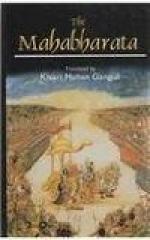15. Sambutatwam is sanhatatwam. Niyachachati is nasyyati Vayu is understood in the second line, or that in the first line of the next verse may be taken as the nom. of niyachachati.
16. Pachante is phalam prayachhanti.
17. Nilakantha explains this verse in a different way. According to him it means,—’in consequence of his subtlety and imperceptibility, Jiva does not become attached to anything. For this reason, one possessed of a knowledge of Brahman, having become cognisant of Brahman and attained the great object of his desire, succeeds in becoming so (i.e., dissociated from all things). This interpretation seems to be a little far-fetched.
18. Chetasa indicates upadhibhutena, for previously, Jiva was without upadhi. Pranasthaneshu implies Indriyagolokeshu or those vital parts which constitute the seats of the senses. Chetana does not, I think, mean ‘consciousness.’ It implies mind.
19. Causes them to grow. I do not follow Nilakantha here.
20. Nilakantha points out that one of the cha’s indicates the reason or cause. Hence, the use of ‘therefore’ in the text.
21. Vikrita does not necessarily mean degraded. It implies ’changed or altered.’ Jiva, who is pure and immaculate, takes birth in this world, failing away from his true status of Brahman owing to his acts. Acts, again, are eternal, no beginning being conceivable.
22. Parantwa-maritam-aksharam indicates two things, viz., Amritam and Aksharam. The first line speaks of Kshara, or the material case, or body; then of that which is para or other. This other is of two kinds, viz., Amritam or suddha-chaitanyam, implying Brahman in its condition of purity; and Aksharamt or Jiva as existing in the material case. In the second line, trayanam refers to Kshara, Amrita, and Akshara. Mithunam is duality, referring to that which is composed of Kshara and Akshara. What is stated in this verse is that every Purusha is a duality, made up of Kshara and Akshara. Telang gives a different version of the verse. He ignores the word trayanam totally, and takes Mithunam as implying a couple (male and female). All the texts I have seen contain trayanam.
23. Atra purvajamnani (vishaye) yatha kaschit Medhavi etc., (vadet). seems to be the correct order of the words. Telang translates the first line differently.
24. Ekayana is the one receptacle of all things, viz., Brahman. Tushni implies ahamevedam sarvamasmityabhimanamapyakurvan i.e., ’without even retaining the consciousness of his own identity with everything.’ Kinchikachintayan—i.e., not even thinking that he is existing. Purvam purvam parityajya implies the gradual merging of the grosser in the subtler. i.e., the successive stages of Yoga before absorption into Brahman. I follow Nilakantha.
25. The first half of the second line of 8 is read differently in the Bengal texts. Aswasthamavasam mudham implies ’without ease or happiness, endued with slavery and ignorance.’




